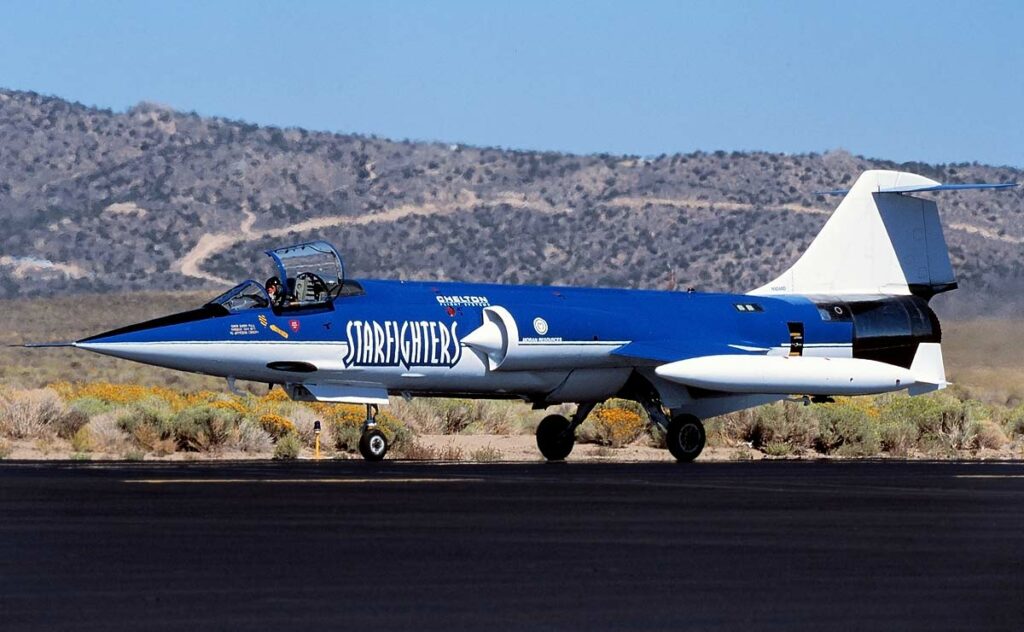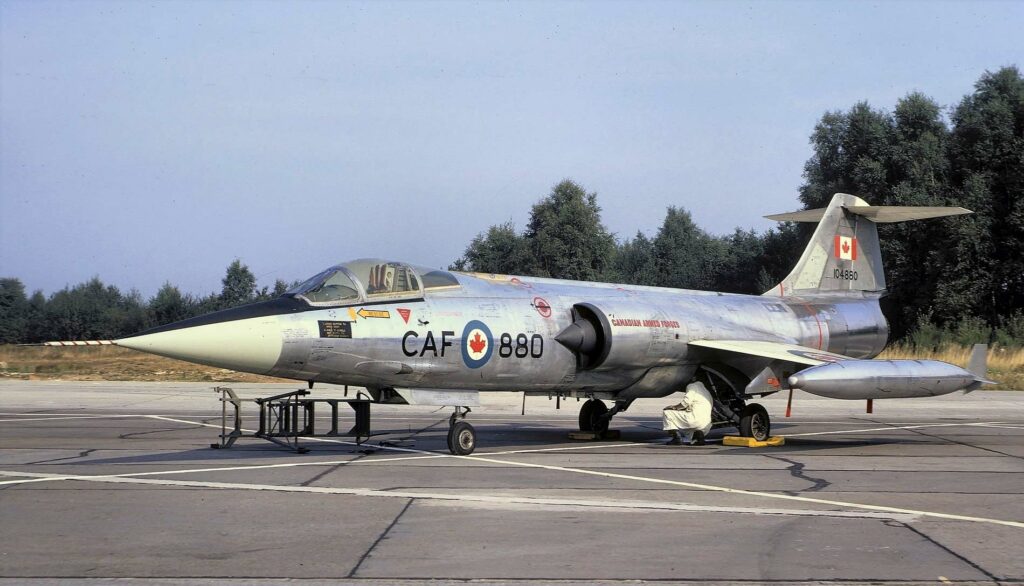The CF-104 Starfighter, known for its supersonic speed and precision, served as a key reconnaissance and strike aircraft in the Cold War era.
In Brief
The Canadair CF-104 Starfighter was a single-engine, high-performance jet aircraft adapted from the Lockheed F-104 Starfighter. Primarily used by the Canadian Armed Forces from the early 1960s to the late 1980s, it featured a slender fuselage, small wingspan, and was powered by an Orenda-built General Electric J79 turbojet engine. This configuration allowed for Mach 2 speeds at altitudes above 50,000 feet, with a range extended by in-flight refueling capabilities. Its armament included a six-barrel M61 Vulcan cannon and the ability to carry nuclear or conventional bombs, making it a formidable platform for strike missions. Additionally, it was equipped with advanced avionics for its time, including navigation and targeting systems, enhancing its role in reconnaissance and precision strike operations.

History of the Development of the Canadair CF-104 Starfighter
During the late 1950s, as the Cold War escalated, NATO countries sought advanced military capabilities to counter the Soviet threat. Canada, in its strategic assessment, identified a need for a versatile, high-speed aircraft capable of performing reconnaissance and nuclear strike missions. The Lockheed F-104 Starfighter, with its exceptional performance characteristics, was chosen as the base model for adaptation.
Canadair, a Canadian aerospace manufacturer, was awarded the contract to produce the CF-104 under license, incorporating modifications to meet specific Canadian and NATO requirements. The program was launched with an emphasis on enhancing the F-104’s nuclear delivery and reconnaissance capabilities. The first Canadian-manufactured CF-104 flew on May 26, 1961, marking a significant milestone in Canada’s defense manufacturing capabilities.
The CF-104 did not receive a unique NATO nickname separate from its F-104 Starfighter lineage, but it was widely recognized among NATO allies for its specialized adaptations and performance enhancements.
Design of the Canadair CF-104 Starfighter
The CF-104’s design was a testament to engineering aimed at achieving high speed and altitude. It featured a unique blend of aerodynamic efficiency and power, courtesy of its General Electric J79-Orenda turbojet engine, producing over 10,000 pounds of thrust, and up to 15,800 with afterburner. The aircraft’s narrow fuselage and small, sharp-edged wings, spanning just 21 feet 9 inches, minimized drag and allowed for speeds up to Mach 2.2.
One of the major advantages of the CF-104’s design was its exceptional performance in the high-altitude, high-speed interception role, complemented by its capability to execute low-level, high-speed strike missions. However, its high-performance design came with drawbacks, including challenging handling characteristics at lower speeds and a high landing speed, which necessitated long runways and skilled piloting.
Performance of the Canadair CF-104 Starfighter
In operational terms, the CF-104 Starfighter excelled in its designated roles. It could climb to 50,000 feet in less than one minute, achieving a maximum speed of Mach 2.2 at altitude. Its range was approximately 1,630 miles (2,623 kilometers), significantly extended by in-flight refueling.
When compared to contemporaries such as the McDonnell Douglas F-4 Phantom II, the CF-104 offered superior speed and altitude performance but lacked in versatility and payload capacity. Its design focused on specific mission profiles, making it a specialized tool in the Cold War arsenal.
Variants of the Canadair CF-104 Starfighter
The CF-104 Starfighter saw several variants over its service life, including the CF-104D, a dual-seat training version. Modifications across variants focused on avionics upgrades, enhanced reconnaissance capabilities, and adaptations for different weapons systems to expand its role from purely nuclear strike to include conventional attack missions.

Military Use and Combat of the Canadair CF-104 Starfighter
The CF-104 served primarily with Canadian forces in Europe, playing a critical role in NATO’s strategic deterrence posture during the Cold War. It was equipped with nuclear and conventional weapons, enabling it to perform a wide range of missions, from deep penetration strikes to tactical reconnaissance.
Although not extensively used in combat, the CF-104’s contributions to NATO’s intelligence and deterrence efforts were significant. Its high-speed reconnaissance missions provided valuable data on Warsaw Pact forces, while its nuclear capability represented a key component of NATO’s strategic arsenal. The aircraft was eventually phased out in the late 1980s, replaced by more modern platforms capable of fulfilling multi-role missions with greater efficiency and safety.
The Canadair CF-104 Starfighter exemplifies the peak of Cold War aviation technology, designed for speed, altitude, and versatility. Despite its challenges, the CF-104 made significant contributions to NATO’s deterrence and reconnaissance capabilities, embodying the technological ambitions and strategic necessities of its era. Its legacy remains a testament to the innovative spirit of its designers and the skill of its pilots, marking a significant chapter in military aviation history.
Back to the Fighter Jet section.